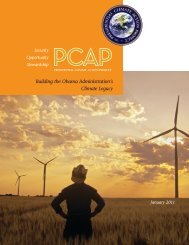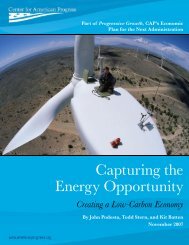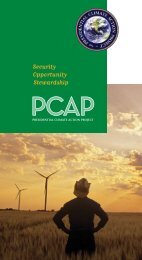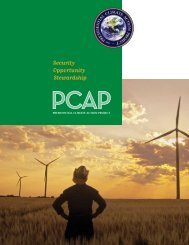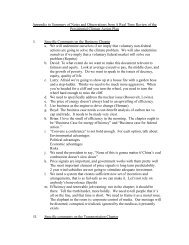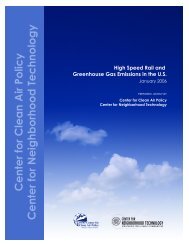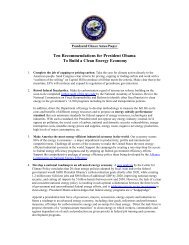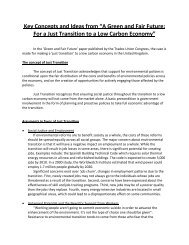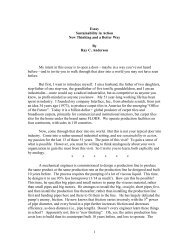PCAP - Presidential Climate Action Project
PCAP - Presidential Climate Action Project
PCAP - Presidential Climate Action Project
- No tags were found...
Create successful ePaper yourself
Turn your PDF publications into a flip-book with our unique Google optimized e-Paper software.
environment.” Based on the policies declared in NEPA and this language, the impacts of globalwarming would fall within the assessment requirements of the Act, including the preparation ofan EIS for actions that are “major Federal actions.”Authority over the Agencies. NEPA applies to all departments (except the EPA). 361 Asestablished above, the CEQ reviews and appraises the various programs and activities of thefederal government, and establishes guidelines and issues regulations to federal agencies for thepreparation of the EIS and other agency responsibilities under the Act. The CEQ’s role,however, is to advise and assist the President.The CEQ is located in the EOP, and the three members are appointed by the President and “serveat the pleasure of President” (by and with the advice and consent of the Senate). Further, thePresident appoints the Chair from its members, and the duties of the Council are explicitly tied to“assisting” the President. 362 Thus, the authority of the President is at its peak over an entity suchas the CEQ. 363 See Proposal E-2 for details. As set forth in E.O. 11472, “The Council shalladvise and assist the President with respect to environmental quality matters and shall performsuch other related duties as the President may from time to time prescribe. In addition, thePresident presides over meetings of the Council.Executive Orders. E.O. 11514, Protection and Enhancement of Environmental Quality (March5, 1970) 364 implements NEPA. Global warming would fall within the environmental issues towhich the executive order applies.A review of executive orders that cite NEPA as a source of authority reveals that the Act isfrequently used as authority to implement policies intended to protect the environment, typicallyin conjunction with other environmental laws, e.g. E.O. 11643, Feb. 8, 1972 (restricting use oftoxic chemicals on federal lands); E.O. 11987, May 4, 1977 (restricting the introduction of exoticspecies into natural ecosystems); E.O. 13089, June 11, 1998 (coral reef protection). 365 However,executive orders have been used to clarify specific concerns that would fall within the NEPAreview process. E.O. 13186 explicitly places impacts on migratory birds within the NEPAreview process: “[each agency shall] ensure that environmental analyses of Federal actionsrequired by NEPA or other established environmental review processes evaluate the effects ofactions and agency plans on migratory birds, with emphasis on species of concern.” 366 E.O.361 42 U.S.C. § 4332(2) (“all agencies shall”).362 Id. at §§ 4342, 4344. See also, 42 U.S.C. § 4372(d) (The Director of the Office who is also the Chairman of theCEQ “shall assist and advise the President on policies and programs of the Federal Government affectingenvironmental quality”).363 See Boundaries Report, Chapter VI, Intro., 1(b), 1(c).364 As amended by Exec. Order No. 11991 (May 24, 1997).365 See also, Exec. Order Nos.: 11870, Environmental Safeguards on Activities for Animal Damage Control onFederal Lands, (July 18, 1975); 11990, Protection of Wetlands, (May 24, 1977); 12962, Recreational Fisheries,(June 7, 1995); 12996, Management and General Public Use of the National Wildlife Refuge System, (Mar. 25,1996); 13112, Invasive Species, (Feb. 3, 1999); and 13158, Marine Protected Areas, (May 26, 2000).366 Exec. Order No. 13186, Responsibilities of Federal Agencies To Protect Migratory Birds, (Jan. 10, 2001).CEES 99 | P age



